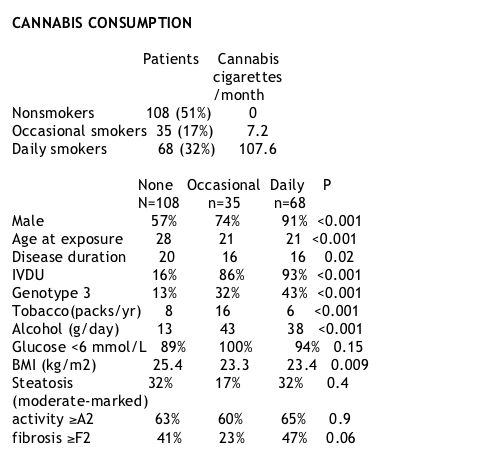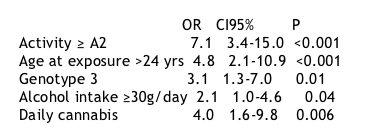| |
Daily Cannabis Smoking as a Risk Factor for Fibrosis Progression in Chronic Hepatitis C
|
| |
| |
A French research group reported results from this study at EASL (April 14-18, 2004, Berlin, Germany).
C. Hezode^{1}, F. Roudot-Thoraval ^{2}, P. Grenard ^{3}, B. Julien ^{3}, E.S. Zafrani ^{4}, D. Dhumeaux ^{1}, S. Lotersztajn ^{3}, A. Mallat ^{1} ^{3}; ^{1}Department of Hepatology, Hopital Henri Mondor, Creteil, France; ^{2}Department of Public Health, Hopital Henri Mondor, Creteil, France; ^{3}INSERM U581, Hopital Henri Mondor, Creteil, France; ^{4}Department of Pathology, Hopital Henri Mondor, Creteil, France
AUTHOR'S CONCLUSIONS: This study shows a strong link between daily cannabis consumption and fibrosis progression rate in patients with chronic hepatitis C. These results support experimental data demonstrating the profibrogenic role of CB1 receptors, see below (Grenart et al). Daily cannabis consumption should be avoided in patients with chronic hepatitis C. In multivariate analysis, fibrosis progression rate >0.08 U per year was independently related to a 4 times greater risk from daily cannabis smoking; alcohol intake _30 grams/day showed double the risk for faster fibrosis progression; age at contamination >24 years was associated with a 4 times greater risk for faster fibrosis progression; and activity _A2 was associated with 7 times greater risk for faster fibrosis progression. Pharmacologic antagonists of CB1 receptors may represent a new approach in the treatment of liver fibrosis.
Note from Jules Levin: Interestingly, Diana Sylvestre found in study that smoking marijuana increased sustained viral response rates of patients on Methadone Maintenance. The suggestion is that smoking pot may have improved adherence and tolerability of interferon/ribavirin therapy.
Several host, viral and environmental factors modulate development of fibrosis in patients with chronic hepatitis C. Progression may occurin the absence of risk factors.
Cannabis sativa, also known as marijuana, contains a predominant psychoactive cannabinoid, tetrahydrocannabinal (THC) and over 60 other cannabinoid compounds.
Biological effects of THC and other cannabinoids are mediated by 2 types of receptors CB1 and CB2.
Study authors said we recently demonstrated the profibrogenic role of CB1 receptors (P Grenard et al):
---CB1 receptors are highly upregulated in hepatic myofibroblasts of human cirrhotic liver samples
---following chronic tetrachloride administration, CB1 knock out mice show reduced fibrosis compared to wild type mice
The AIM OF THIS STUDY is to evaluate the impact of cannabis smoking on fibrosis progression rate in patients with chronic hepatitis C.
PATIENTS
--211 consecutive naïve patients with histologically proven chronic hepatitis C
--known disease duration
--no HBV or HIV coinfection
--no previous immunosuppression
METHODS
Epidemiological data:
--gender
--age at exposure, duration og HCV infection
Alcohol and tobacco consumption over the course of infection
Cannabis questionnaire:
--age at onset and duration of smoking
--amount and frequency of cannabis cigarettes
BMI and glucose fasting level
Genotype (INNO-LIPA HCV II, innogenetics)
Activity, fibrosis, and steatosis: METAVIR
ENDPOINTS
Fibrosis progression rate (fibrosis stage/duration of infection)
--rapid fibrosers: >0.08 U/yrs (median value
Significant fibrosis: ≥F2 (METAVIR)

FIBROSIS PROGRESSION RATE >0.08 U/year: Univariate analysis
AGE
Fibrosis Rate >0.08 U/yr
P=0.01
≦24 yrs: 41%
>24 yrs: 59%
ALCOHOL
Fibrosis Rate >0.08 U/yr
P=0.007
<30 grams/day: 42%
>30 grams/day: 62%
GENOTYPE
FibrosisRate >0.08 U/yr
P=0.005
Non 3: 42%
Genotype 3: 65%
GLUCOSE
Fibrosis Rate >0.08 U/yr
P=0.006
Glucose ≦6: 46%
Glucose >6: 81%
STEATOSIS
Fibrosis Rate >0.08 U/yr
P=0.001
Absent/mild: 41%
Moderate/marked: 65%
ACTIVITY
Fibrosis rate >0.08 U/yr
P<0.001
A1: 22%
≥A2: 64%
CANNABIS
FIBROSIS RATE >0.08 U/yr
P=005
None: 41%
Occasional: 40%
Daily: 65%
MULTIVARIATE ANALYSIS

FIBROSIS STAGE and DAILY CANNABIS SMOKING ACCORDING TO AGE AT LIVER BIOPSY
If ≥ 40 yrs old: 58% of DAILY SMOKERS vs 44% of non & occasional smokers had Fibrosis ≥ F2.
If <40 yrs old: 23% of non and occasional smokers vs 43% of daily smokers had Fibrosis ≥ F2.
FIBROSIS STAGE and DAILY CANNABIS SMOKING ACCORDING TO AGE AT LIVER BIOPSY AND ALCOHOL INTAKE
DIFFERENCES SIGNIFICANT
If < 40 yrs old & alcohol <30 grams/day: 20% of non and occasional smokers vs 37% of daily smokers had Fibrosis ≥ F2.
If ≥ 40 yrs old & alcohol <30 grams/day: 35% of non and occasional smokers vs 71% of daily smokers had Fibrosis ≥ F2.
DIFFERENCES NOT SIGNIFICANT
If Alcohol >30 grams/day and < 40 yrs old: 38% of non and occasional smokers vs 50% of daily smokers had Fibrosis ≥ F2.
If Alcohol > 30 grams/day and > 40 yrs old: 76% of non and occasional smokers vs 50% of daily smokers had Fibrosis > F2.
|
|
| |
| |
|
|
|